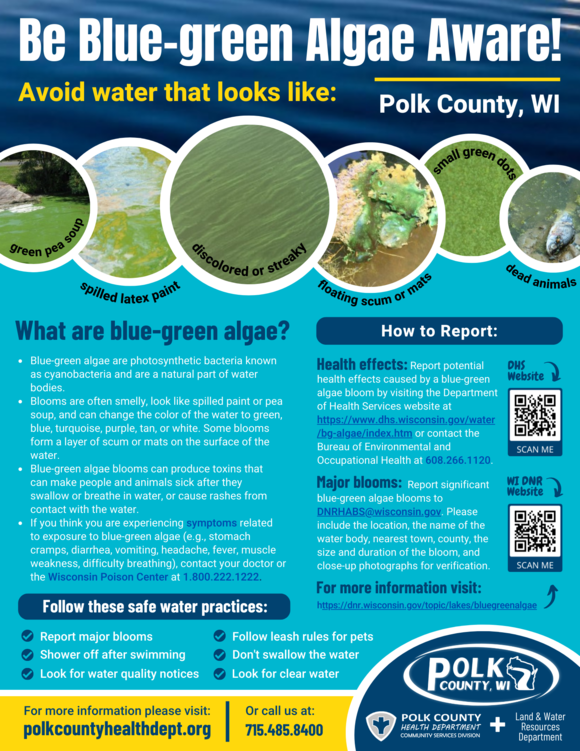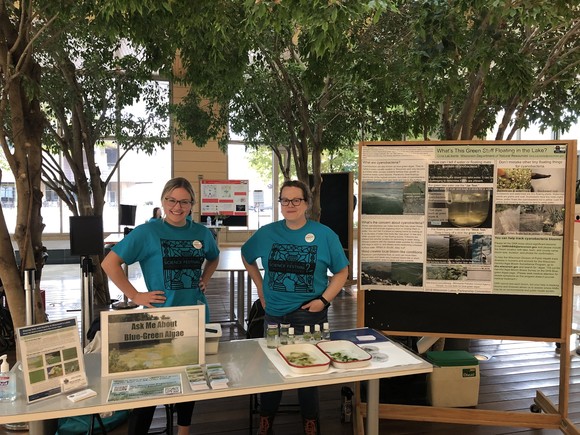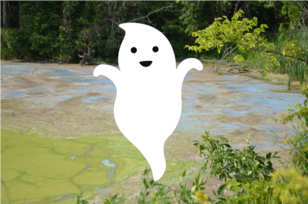 A Shoutout to Wisconsin's Local HAB Efforts
The harmful algal bloom (HAB) season is officially coming to an end. While this summer was certainly a busy one for the DHS, local health departments throughout Wisconsin were also hard at work making sure their communities were safe from harmful algal blooms. We value our partnerships with local health departments and appreciate the work they do to promote and protect public health. Keep reading to learn what a couple of our local partners have been up to!
“Be Blue-green Algae Aware!”: New outreach materials from Polk County
The Polk County Health Department and Polk County Land and Water Resources Department has compiled a collection of blue-green algae resources including fact sheets, bookmarks, and social media messages. Polk County plans to distribute these on an annual basis through social media platforms, the Polk County website, local newspapers as well as sharing materials directly with lake organizations, towns, villages, and city officials.
One of their resources is an educational flyer aimed to help Polk County residents understand what blue-green algae are, their potential health effects, and how to report blooms and related illnesses. This flyer is informative and fun! Check it out:
 Eau Claire’s newest blue-green algae monitoring plan
The Eau Claire City-County Health Department (ECCCHD) has updated their beach monitoring program. Since 2016, water quality advisories and guidance have been posted when blue-green algae are present. ECCCHD decided to implement a refined approach to managing harmful algal blooms this year. Their newest guidelines include issuing a beach closure when a visible bloom is present in the swimming area of a public beach.
In the absence of a visible bloom, ECCCHD still issues a water quality advisory if their field measurement tool estimates an elevated cyanotoxin level. During a closure or advisory, additional monitoring is conducted each subsequent business day until cyanotoxin levels drop to a safe level. ECCCHD monitors surface water using an AlgaeTorch, which provides a quick reading of blue-green algae chlorophyll-a measurements in the field. The AlgaeTorch differentiates between the chlorophyll content of cyanobacteria and the chlorophyll content of all other microalgae present.
According to ECCCHD, this program update has had several successes. There has been improved awareness of harmful algal blooms and an uptick in attention to current beach statuses within the community. The ECCCHD has also successfully implemented additional messaging and updated signage to alert residents of the associated health risks of harmful algal blooms. These actions have improved the ECCCHD’s knowledge of blooms and their efforts to keep Eau Claire’s recreational water safe and enjoyable for their community.
Be featured with us!
Do you have a blue-green algae resource you’d like to share? We are looking for other local outreach examples to feature in future newsletters. If you have any materials that you’re proud of (a bookmark, sign, fact sheet, etc.), send them our way by emailing the DHSHABS team.
Event Highlight: The Wisconsin Science Festival (10/10–10/16)
Jordan Murray (DHS’s HAB Program Coordinator, pictured below, left) and Gina LaLiberte (Statewide HAB Coordinator at the Department of Natural Resources, pictured below, right), recently participated in the Wisconsin Science Festival in Madison. This weeklong event was a statewide celebration that featured educational activities for people of all ages.
The Wisconsin HABs Team had the opportunity to educate attendees about safe versus harmful algae. They discussed the health effects associated with exposure to blue-green algae and how people and pets can protect themselves. Visitors also had the chance to check out Gina’s “algae zoo”—a unique collection of preserved and live algal species available for close inspection.

Upcoming Events
11th U.S. Symposium on Harmful Algae: 10/23–10/29
Jordan Murray will be presenting novel research at the 11th U.S Symposium on Harmful Algae in Albany, New York at the end of October. Her presentation will focus on the relationship between harmful algal blooms and respiratory-related hospital visits. She will be presenting alongside Centers for Disease Control and Prevention (CDC) partners. If you’re interested in learning more about this work, you can email Jordan.
Wisconsin Environmental Health Association (WEHA) Annual Conference: 10/26–10/28
While Jordan is in New York, her mentor and predecessor, Amanda Koch, will be presenting about blue-green algae at the 2022 WEHA Annual Conference in Lake Geneva.
Amanda’s presentation will discuss how our program collects and investigates HAB-related health complaints and showcase available program resources to improve awareness, understanding, and reporting of HABs and HAB-related illnesses in Wisconsin. Catch Amanda on Friday, 10/28!
 |
|
Let's Get Social!
Joke of the Day
|
 |
|
Q: What type of “algae” is made of bacteria, can produce toxins, and grows in a haunted lake?
A: BOO-green algae! Learn more on our website.
|
Stay in Touch
 |
|
Missed a past issue? Previous issues are available on our Resources for Health Professionals webpage.
Email us your burning questions! If others can benefit from hearing the answer to your question, we’ll feature it in a future issue.
Remember that we are always available for consultation on any HAB health-related issue by email or phone (608-266-1120).
|
|